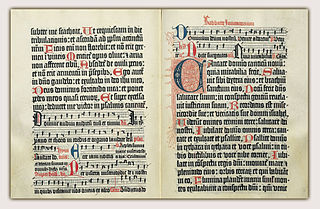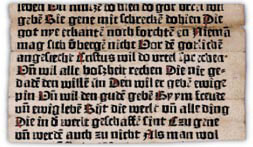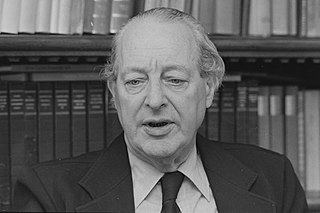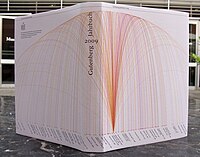
Johannes Gensfleisch zur Laden zum Gutenberg was a German inventor and craftsman who introduced letterpress printing to Europe with his movable-type printing press. Though movable type was already in use in East Asia, Gutenberg invented the printing press, which later spread across the world. His work led to an information revolution and the unprecedented mass-spread of literature throughout Europe. It also had a direct impact on the development of the Renaissance, Reformation, and humanist movements, as all of them have been described as "unthinkable" without Gutenberg's invention.

Mainz, previously known in English as Mentz or Mayence, is the capital and largest city of Rhineland-Palatinate, Germany.

The Gutenberg Museum is one of the oldest museums of printing in the world, located opposite the cathedral in the old part of Mainz, Germany. It is named after Johannes Gutenberg, the inventor of printing from movable metal type in Western Europe. The collections include printing equipment and examples of printed materials from many cultures.

The Gutenberg Bible was the earliest major book printed using mass-produced movable metal type in Europe. It marked the start of the "Gutenberg Revolution" and the age of printed books in the West. The book is valued and revered for its high aesthetic and artistic qualities as well as its historical significance. It is an edition of the Latin Vulgate printed in the 1450s by Johannes Gutenberg in Mainz, in present-day Germany. Forty-nine copies have survived. They are thought to be among the world's most valuable books, although no complete copy has been sold since 1978. In March 1455, the future Pope Pius II wrote that he had seen pages from the Gutenberg Bible displayed in Frankfurt to promote the edition, and that either 158 or 180 copies had been printed.
The Summa grammaticalis quae vocatur Catholicon, or Catholicon, is a 13th-century Latin dictionary which found wide use throughout Latin Christendom. Some of the entries contain encyclopedic information, and a Latin grammar is also included. The work was created by John Balbi, of Genoa, a Dominican, who finished it on March 7, 1286. The work served in the late Middle Ages to interpret the Bible. The Catholicon was one of the first books to be printed, using the new printing technology of Johannes Gutenberg in 1460.

Peter Schöffer or Petrus Schoeffer was an early German printer, who studied in Paris and worked as a manuscript copyist in 1451 before apprenticing with Johannes Gutenberg and joining Johann Fust, a goldsmith, lawyer, and money lender.

The global spread of the printing press began with the invention of the printing press with movable type by Johannes Gutenberg in Mainz, Germany c. 1439. Western printing technology was adopted in all world regions by the end of the 19th century, displacing the manuscript and block printing.
Jeffrey F. Hamburger is an American art historian specializing in medieval religious art and illuminated manuscripts. In 2000 he joined the faculty of Harvard University, where in 2008 he was appointed the Kuno Francke Professor of German Art and Culture. Hamburger received his B.A., M.A and Ph.D from Yale and has previously held professorships at Oberlin College and the University of Toronto. Elected a Fellow of the Medieval Academy in 2001, he has won numerous awards for his publications, among them: the Charles Rufus Morey Prize of the College Art Association (1999), the Roland H. Bainton Book Prize in Art & Music (1999), the Otto Gründler Prize of the International Congress on Medieval Studies (1999), the Jacques Barzun Prize in Cultural History of the American Philosophical Society (1998), the John Nicholas Brown Prize of the Medieval Academy of America (1994), and the Gustave O. Arlt Award in the Humanities of the American Council of Graduate Schools (1991). His research has been supported by fellowships from the Guggenheim Foundation, the American Philosophical Society, the Institute for Advanced Study, the National Endowment for the Humanities, the Center for Advanced Study in the Visual Arts, and the Alexander von Humboldt Foundation. In 2009 Hamburger was elected a member of the American Academy of Arts and Sciences and in 2010, of the American Philosophical Society. In 2015 he was awarded an Anneliese Maier Research Award by the Alexander von Humboldt Foundation. In 2022 he was awarded the Gutenberg Prize of the City of Mainz and the Internationale Gutenberg-Gesellschaft.

The Mainz Psalter was the second major book printed with movable type in the West; the first was the Gutenberg Bible. It is a psalter commissioned by the Mainz archbishop in 1457. The Psalter introduced several innovations: it was the first book to feature a printed date of publication, a printed colophon, two sizes of type, printed decorative initials, and the first to be printed in three colours. The colophon also contains the first example of a printer's mark. It was the first important publication issued by Johann Fust and Peter Schoeffer following their split from Johannes Gutenberg.

The Sibyllenbuchfragment is a partial book leaf which may be the earliest surviving remnant of any European book that was printed using movable type. The Sibyllenbuch, or Book of the Sibyls, was a medieval poem which held prophecies concerning the fate of the Holy Roman Empire.

Steidl is a German-language publisher, an international publisher of photobooks, and a printing company, based in Göttingen, Germany. It was started in 1968 by Gerhard Steidl and is still run by him.
The Hochschule für Musik Mainz is a university of music, part of the Johannes Gutenberg University of Mainz. It is the only such institution in the German state of Rhineland-Palatinate.
Thomas Giegerich is a German jurist. He is professor for European law, international law and public law at Saarland University and director of the Europa-Institut, Saarbrücken.
The following is a timeline of the history of the city of Bonn, North Rhine-Westphalia, Germany.

Henri Friedlaender (1904–1996) was an Israeli typographer and book designer. He co-founded the Hadassah Printing School and served as the first director of the school.

Ricardo J. Vicent Museros was a Spanish printer and publisher. After studying in Germany he returned to Valencia with new methods of work, advertising and graphic marketing. He founded the "Museo Nacional de la Imprenta y la Obra Gráfica" in El Puig de Santa María. He promoted the twinning of the cities of Valencia and Mainz (Germany). In 1992, the International Gutenberg Society granted him the "Gutenberg Prize" and in 2003 he received the "Cross of Civil Merit" from the German government for his work in favour of cultural relations between Spain and Germany.
Alan Marshall is a British historian who works in France. He specialised in the history of printing, in particular that of phototypesetting.
The Gutenberg Prize of the International Gutenberg Society and the City of Mainz has been awarded since 1968 for outstanding artistic, technical and scientific achievements in the field of printing. The award was initially awarded every three years, since 1994 then in annual change with the Gutenberg Prize of the City of Leipzig, which also honors outstanding book art achievements. The Gutenberg Prize is endowed with 10,000 euros.
Hellmut Otto Emil Lehman-Haupt was a German-American author, academic, bibliography expert, and rare books expert. After World War II, he worked with the Monuments, Fine Arts, and Archives program, commonly known as the Monuments Men.

Geritt Willem Ovink, was a Dutch professor of History and Aesthetics of Printing Art, and legibility researcher. He was a laudator of the second Gutenberg Prize winner Henri Friedlaender.












